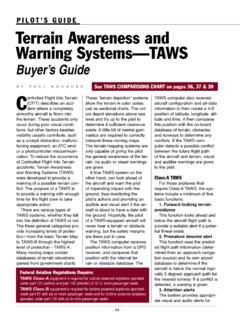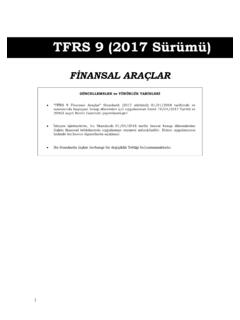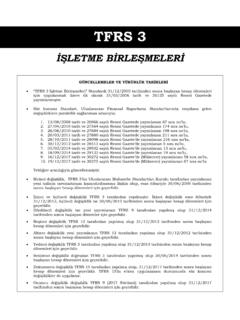Transcription of Traffic Alert Collision Avoidance Systems—TCAS
1 - 26 -P I L O T S G U I D EI can tell you from personal experience that it only takes one Alert from your Traffic advisory system to make you never want to fly without it again. Having that extra set of electronic eyes that can see Traffic above, behind, below you, through haze, precipitation, clouds, darkness you name it, is something no pilot should ever want to leave home without. But realizing that you need it is just the beginning. Next, you have to decide which type of traf-fic Avoidance system is right for your type of flying.
2 The first step is to understand what the pri-mary technologies are, and what they can, and cannot do. AEA s Pilot s Guide To Avionics has put together this Consumer s Guide of the different technologies to help you make an informed ReceiversPassive units listen for the transponder signals from other aircraft in your immediate area. When one or more are detected, these units provide a visual and/or aural signal that it s time to start looking out the window. Because they use a single antenna, they often suffer from blind spots.
3 Passive technology is what you find primarily in por-table units, which are great for renter pilots and flight instructors. Traffic Information SystemAny Mode S transponder equipped aircraft can utilize the Traffic Information System (TIS). The TIS is a ground-based service that utilizes the Mode S datalink to communicate colli-sion Avoidance information to the aircraft. The system can show location, direction, altitude and climb/descent trends of other transponder-equipped aircraft within 5 nm and 1,200 feet of your aircraft.
4 Threat Traffic infor-mation can be displayed on the Mode S transponder or a variety of cockpit units including many popular multi-function displays. The only real drawback is that TIS coverage is currently not available in all areas. Traffic Advisory System Traffic Advisory Systems (TAS) monitors the airspace around your aircraft and indicates where to look for nearby transponder-equipped aircraft. TAS systems are active because they provide Traffic Alert Collision Avoidance Systems TCASB uyer s GuideB Y D A L E S M I T HFrom tiny pocket portables to top-end systems that tell you which way to go to avoid trading paint with other aircraft, today there is no reason not to take advantage of all the additional safety tools Collision Avoidance technology has to offer.
5 See TCAS COMPARISONS CHART on pages 28, 29 & 31- 27 -a greater degree of informa-tion from surrounding aircraft by actually interrogating another aircraft s transponder for criti-cal position and trend informa-tion. When they receive a reply from an aircraft that s current course will bring it within the critical area, information about the threat aircraft s position is displayed and an aural warning is given. Many TAS units will also give a LOOK UP/LOOK DOWN clue to help you locate the threat aircraft. Like the TIS system, their Traffic information can be displayed on many leading MFD units.
6 Traffic Alert Collision Avoidance System (TCAS) I and TCAS IITCAS consists of a transmitter, receiver, directional antennas, computer and cockpit displays. TCAS sends out a signal, called an interrogation, that is picked up by another aircraft s transpon-der, which sends back a reply. The TCAS computer uses that reply to calculate distance and direction of the replying aircraft. The information also displays relative altitude and whether the target aircraft is climbing or descending. Should the aircraft be determined to be a threat, this information is used to dis-play a Traffic Advisory (TA).
7 During a TA, a synthesized voice announces, Traffic , Traffic and the symbol on the display changes from a white diamond to a solid yellow circle. TCAS II adds an additional function called a Resolution Advisory (RA). During an RA the threat aircraft s symbol changes from a solid yellow circle to a red square, and the aural system will demand a maneuver such as Climb, Climb or Descend, Descend, or it may tell the pilot NOT to maneuver. Regulations permit only commands for verti-cal maneuvers, not a TCAS II issues an RA involving another TCAS II-equipped aircraft, it coordinates with the other aircraft s system to avoid mirror-image maneu-vers, such as having both aircraft Dependent Surveillance Broadcast (ADS-B)ADS-B is the first leg of the FAA s Free Flight System where each aircraft is responsible for its own navigation and separa-tion.
8 An ADS-B equipped aircraft sends its identification along with speed and precise vertical and horizontal positions to the Global Navigation Satellite System (GNSS) constellation. This infor-mation is instantly broadcast over the entire GNSS network to other ADS-B equipped aircraft, as well as, ADS-B ground stations which then send it along to ATC in real time. Everyone virtually knows what everyone else in their vicin-ity is doing without a word being spoken. And unlike radar, ADS-B is not affected by an aircraft s altitude or range from a station so you can even track aircraft on the ground.
9 And since it is indepen-dent of ground-based radars, it provides perfect location and Traffic information in mountain-ous terrain or in the middle of the ocean. The only drawback is that there are so few aircraft equipped with ADS-B, so for the foreseeable future, you ll still be flying under the watchful eye of ATC. GarminGarmin s GTX 330/330D is an IFR-certified panel-mount tran-sponder with datalink capability including such services as ADS-B and local Traffic updates. Their GNS 430 or GNS 530 displays Traffic Information Services (TIS), with outputs including Traffic loca-tion, direction, altitude, and climb/descent information.
10 Garmin s GTX 330 and GTX 330D meet requirements of Level 2 Mode-S to satisfy upcoming European Mode-S Mandate for Elementary 330/330D features easy-to-read DSTN Liquid Crystal Display and an innovative key-pad with dedicated VFR button. The unit also provides several timing and display functions, remote indent, plus altitude moni-tor with voice GTX 330D adds antenna diversity for improved visibility to TCAS-equipped aircraft flying above you. The GDL 90 is a Universal Access Transceiver (UAT) that is certified to support a broad array of ADS-B broadband services.










